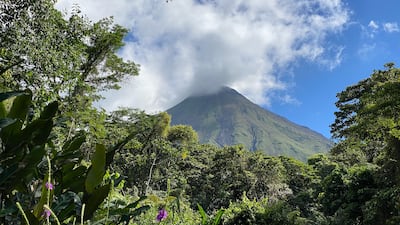On Monday, a volcanic eruption south of Iceland’s capital Reykjavik sent plumes of smoke across a destination that is famed for its craggy volcanoes and geothermal activity. The eruption is now slowing, but not before tourists and other spectators were spotted venturing into the uninhabited area, which is about 30km south-west of the capital.
Despite warnings form Icelandic authorities to stay away, the lure of the lava beckoned and it's not the first time that an erupting volcano has captivated travellers.
Nature's volatile beauty has always intrigued the human imagination, and few of its manifestations are as awe-inspiring as the sight of an active volcano.
The power of devastation and rebirth, the smouldering intensity and the unpredictable allure of these geological marvels beckons intrepid travellers, promising both danger and enchantment.
While venturing close to an active volcano is never without risks – and travellers should always check locally for the latest updates – there are certain destinations around the world where thrill-seekers can experience the primordial spectacle of volcanic activity in relative safety. Here are six of the best.
Arenal Volcano, Costa Rica
Arenal Volcano is young at only 7,500 years old, and it has the looks to prove it. At more than 1,600 metres high, and with the chiselled conical appearance one expects of a stunning stratovolcano, Arenal was also Costa Rica’s most active volcano until 2010.
It has calmed down considerably, and today visitors to La Fortuna in north-western Costa Rica regularly come to walk and horse-ride on its picturesque, relatively safe slopes. After a hard day’s hike, you can visit Tabacon Thermal Resort and Spa in the jungle at the foot of the volcano, where waterfalls, streams and pools that have been geothermally heated by the very heart of Arenal, will soothe legs made weary from the trek.
Stromboli, Aeolian Islands, Italy

The Aeolian Islands, off the coast of Sicily, are home to Mount Stromboli, a volcano renowned for its regular, but relatively mild eruptions. Despite measuring only 924 metres above sea level, Stromboli is known as the Lighthouse of the Mediterranean because it has spewed fountains of lava for about 2,500 years.
Visitors can take a ferry to Stromboli Island where local guides – who have lived under the constant threat of annihilation for generations – take travellers on sunset hikes up the volcano to witness the “Strombolian” explosions – remarkable displays reminiscent of fireworks. Those who wish to maintain a respectful distance, can do so on a boat trip from Sicily, watching fiery lava bursts against the backdrop of a setting sun, from the safe embrace of the Tyrrhenian Sea.
Kilauea, Hawaii, US

An essential destination for volcano enthusiasts, Kilauea’s allure lies not only in its thrilling and consistent volcanic activity, but also in the opportunity to witness the geological processes that continue to shape our planet. The Big Island is the youngest and largest of the Hawaiian islands, and it is still growing thanks to the continuous lava flow from Kilauea into the ocean.
Start your journey from Hilo, where a scenic drive leads to Hawaii Volcanoes National Park. Here, well-maintained trails and informative visitor centres offer insights into the volcano's geological wonders. Despite its active nature, Kilauea is relatively safe to visit due to diligent monitoring and comprehensive safety measures. Park rangers and experts ensure that visitors can explore the volcano while minimising risks, making it an accessible destination for adventurers of all levels.
Pacaya, Guatemala

Situated about 30km south of Guatemala City, Pacaya is one of the most active volcanoes in Central America and also one of the easiest to visit. Classified as a complex stratovolcano, it rises to a height of 2,552 metres, offering vertiginous views of the surrounding landscapes.
Several tour companies provide guided excursions that allow tourists to hike to the volcano's summit. The journey typically involves trekking through volcanic ash and lava fields to witness the impressive lava flows up close. Pacaya invites explorers to tread the fine line between peril and poetry, providing an adrenalin-filled encounter with nature's elemental power, but with proper guidance and safety precautions.
Mount Bromo, Java, Indonesia

Wowing visitors with its lunar landscapes, Bromo Tengger Semeru National Park in Indonesia is one of the most enticing volcanic experiences on the planet. The park is home to five volcanoes – four of which remain active – that have formed within the caldera of a larger ancient one.
The most famous is Mount Bromo, 2,329 metres high, and one of the most visited destinations in Java. A short drive from Surabaya, Malang, or Probolinggo brings you to the base of Mount Bromo, from where you can embark on jeep tours around the Tengger Sand Sea, before riding on horseback or hiking to Bromo’s breathtaking viewpoints. Tours usually arrive at dawn, just in time to see the sunrise illuminating the volcano’s caldera, plus the highest mountain in Java, Mount Semeru, which stands at a towering 3,676 metres.
Mount Yasur, Tanna, Vanuatu

Touted as the planet’s most accessible volcano, due to the fact that travellers can drive to within 200 metres of its main vent, Mount Yasur is the physical and metaphorical pinnacle of an epic adventure. Located in the remote South Pacific, on the island of Tanna in the archipelagic state of Vanuatu, the journey to Mount Yasur concludes with a rugged, two-hour 4X4 ride through wild forests and across barren ash planes of shifting black sand.
Here, travellers can spot fine threads of Pele’s Hair, named after a Hawaiian fire goddess – airborne molten lava that has been caught by the breeze and wind-spun into strands of filament. A short hike then ends on the very rim of the volcano at sunset, where you’ll be so close to the churning magma below that you’ll feel its searing heat on your skin. As night falls, the faces of your travel companions will be lit up – just like the ash clouds above – with the glow of lava.

